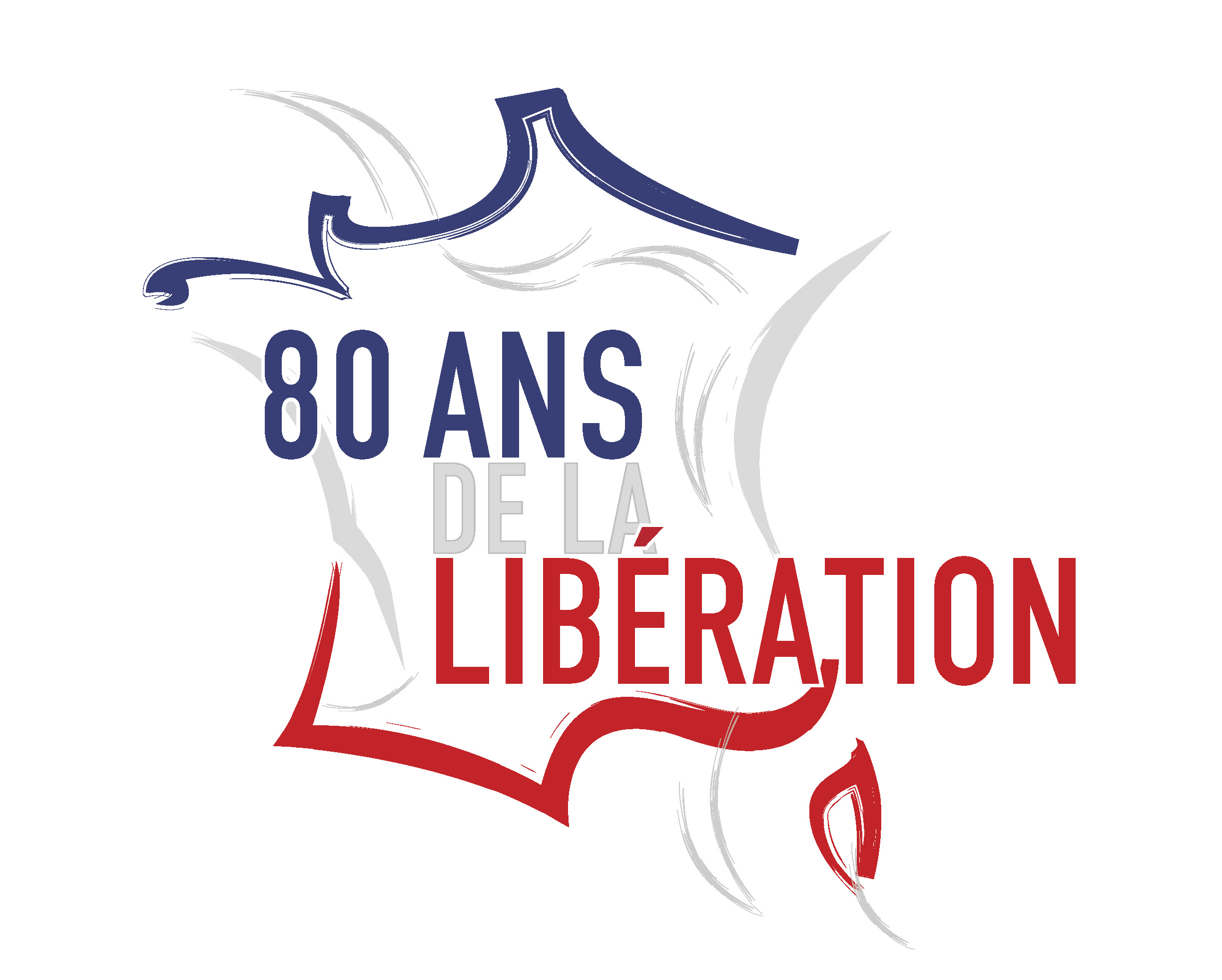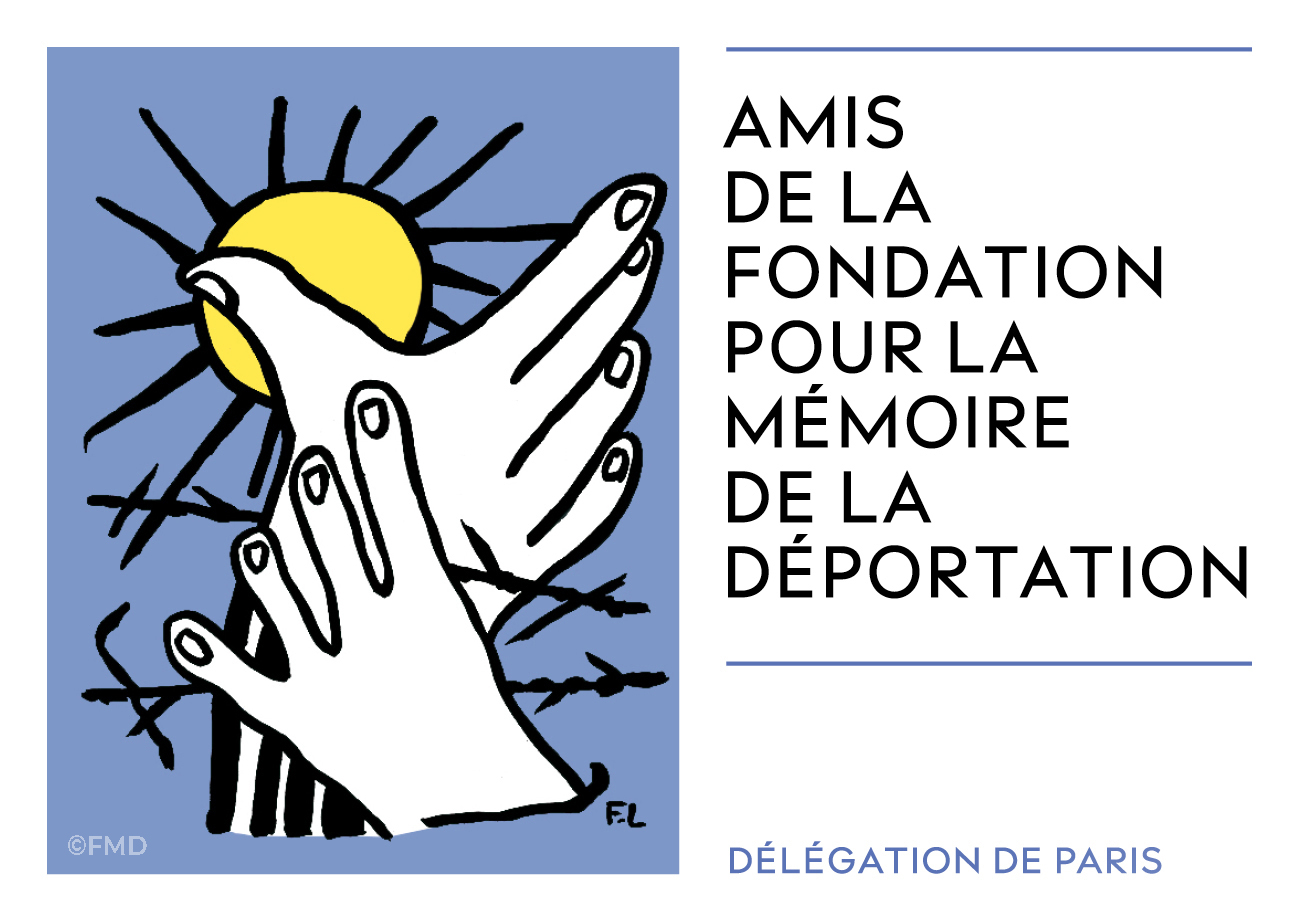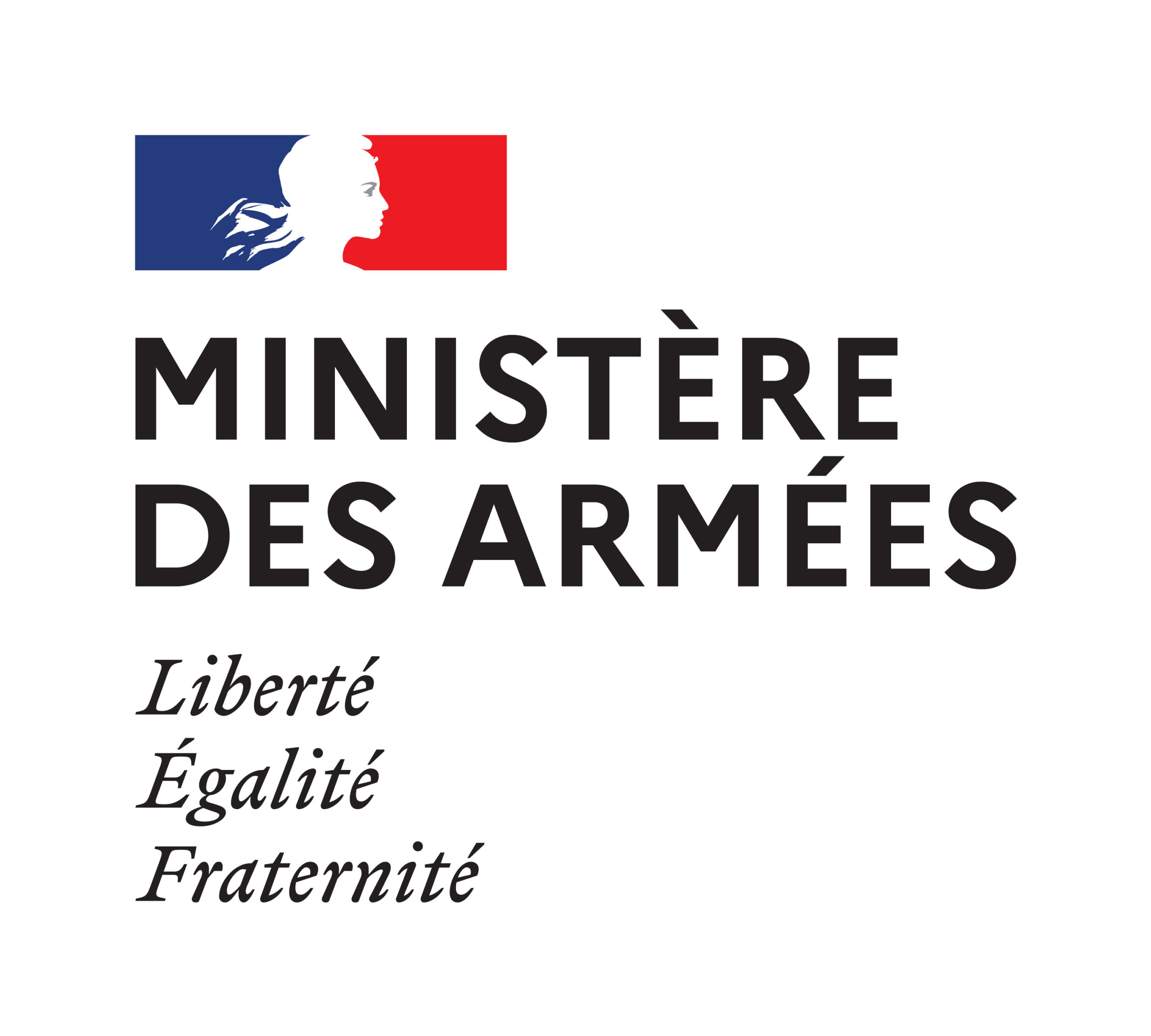NEUENGAMME
Autonomous camp in 1940
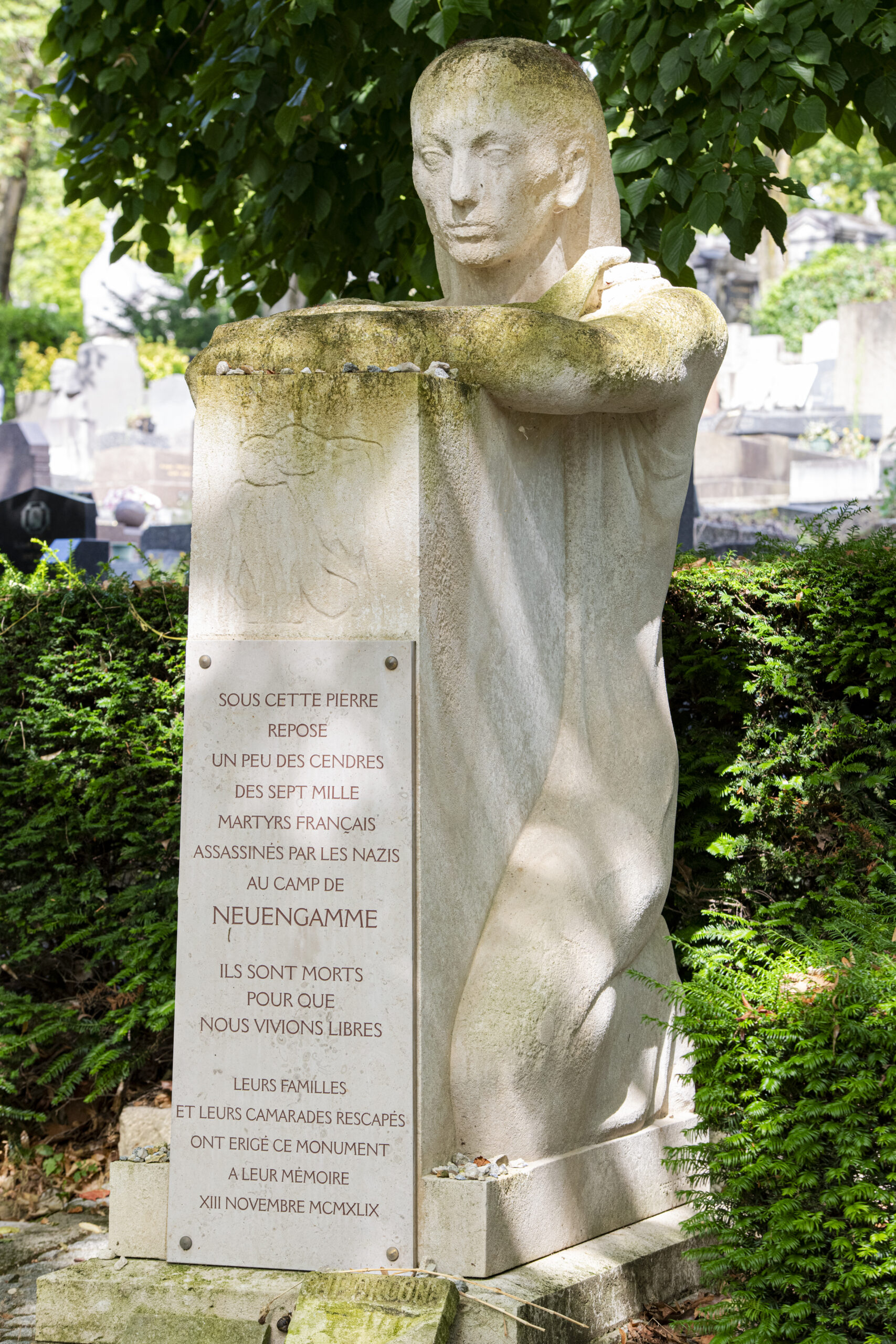
© Vincent Gerbet
Monument Description
Carved by Pierre Honoré, Grand Prix de Rome, in the stone of Vilhonneur, the monument of Neuengamme, inaugurated on November 13, 1949, represents a figure of a woman crouching, her arms resting on an engraved block, her gaze lost in the distance.
It symbolizes the maintenance of hope and humanity having overcome brute force.
The female figure shows the traces of the weight loss and exhaustion of the deportees.
On the front of the block, are carved three flat silhouettes, pressed against each other. They testify to the fragility of the condition of the deportees, but also underline the importance of solidarity to maintain survival.
At the foot of the monument is a stone carved in tribute to the victims of «Cap Arcona». (A piece of wood from the boat has disappeared!).
On the stele is inscribed :
“Beneath this stone lies the ashes of the seven thousand French martyrs murdered by the Nazis at the Neuengamme camp.
They died so we could live free.
Their families and fellow survivors erected this monument in their memory.
13th November MCMXLIX”
Neuengamme camp
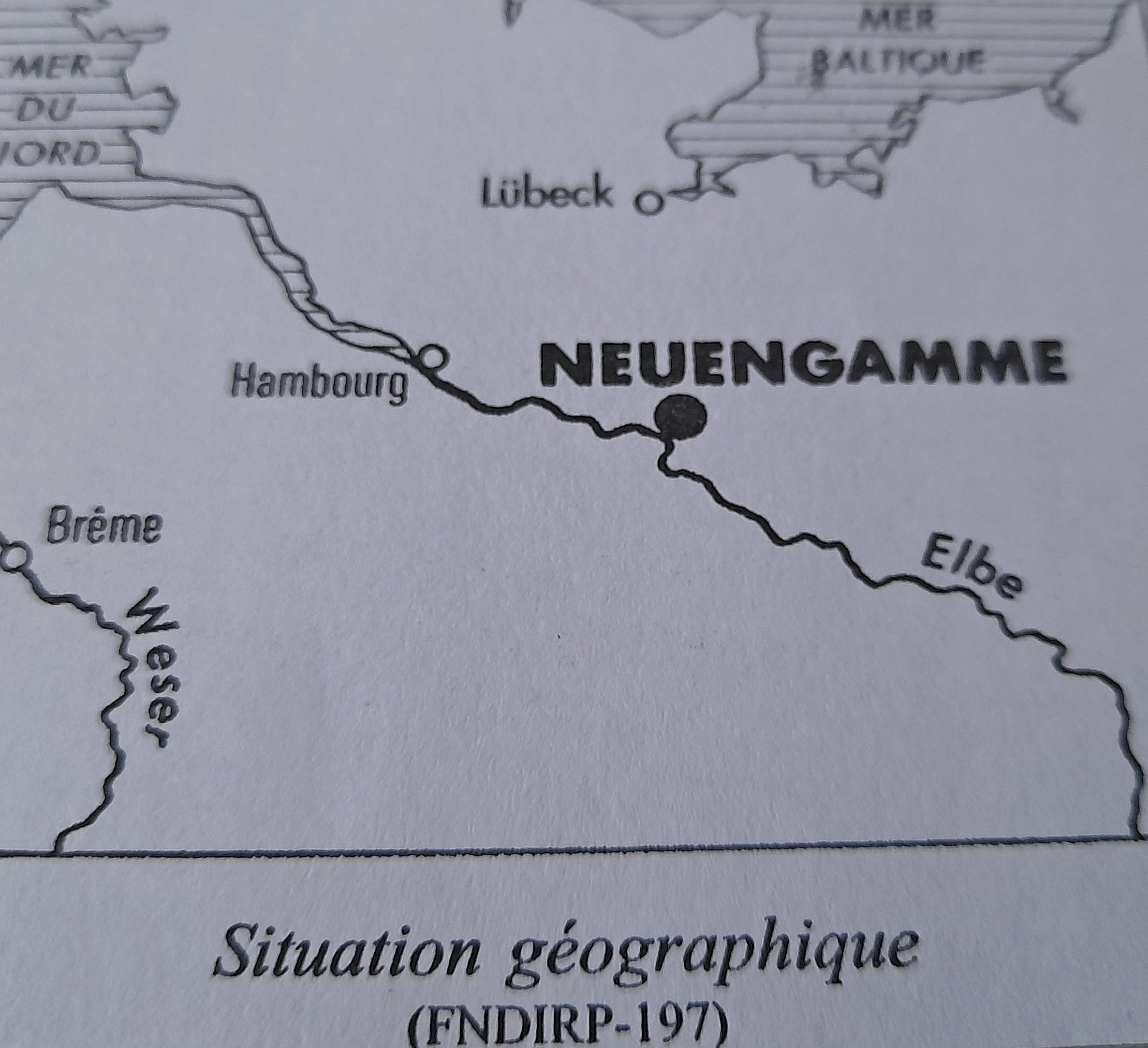
© FNDIRP
Since 1935, the SS had planned to build a new concentration camp near Hamburg. On 13 December 1938, the SS established a kommando outside the Sachsenhausen camp in Neuengamme, southeast of Hamburg on the Elbe, in a disused brickworks belonging to the Dest (see glossary).
The prisoners built a large concentration camp and a brickworks whose production was to be used to « modernize » the banks of the Elbe, to make Hamburg a showcase of National Socialism (major works, bridge over the Elbe, canal connecting the Elbe…).
The city of Hamburg finances the company with a loan of one million Reichsmarks.
Central camp of northwest Germany, it became autonomous in 1940 with more than 80 kommandos. His motto is: «Arbeit macht frei» (work makes you free).
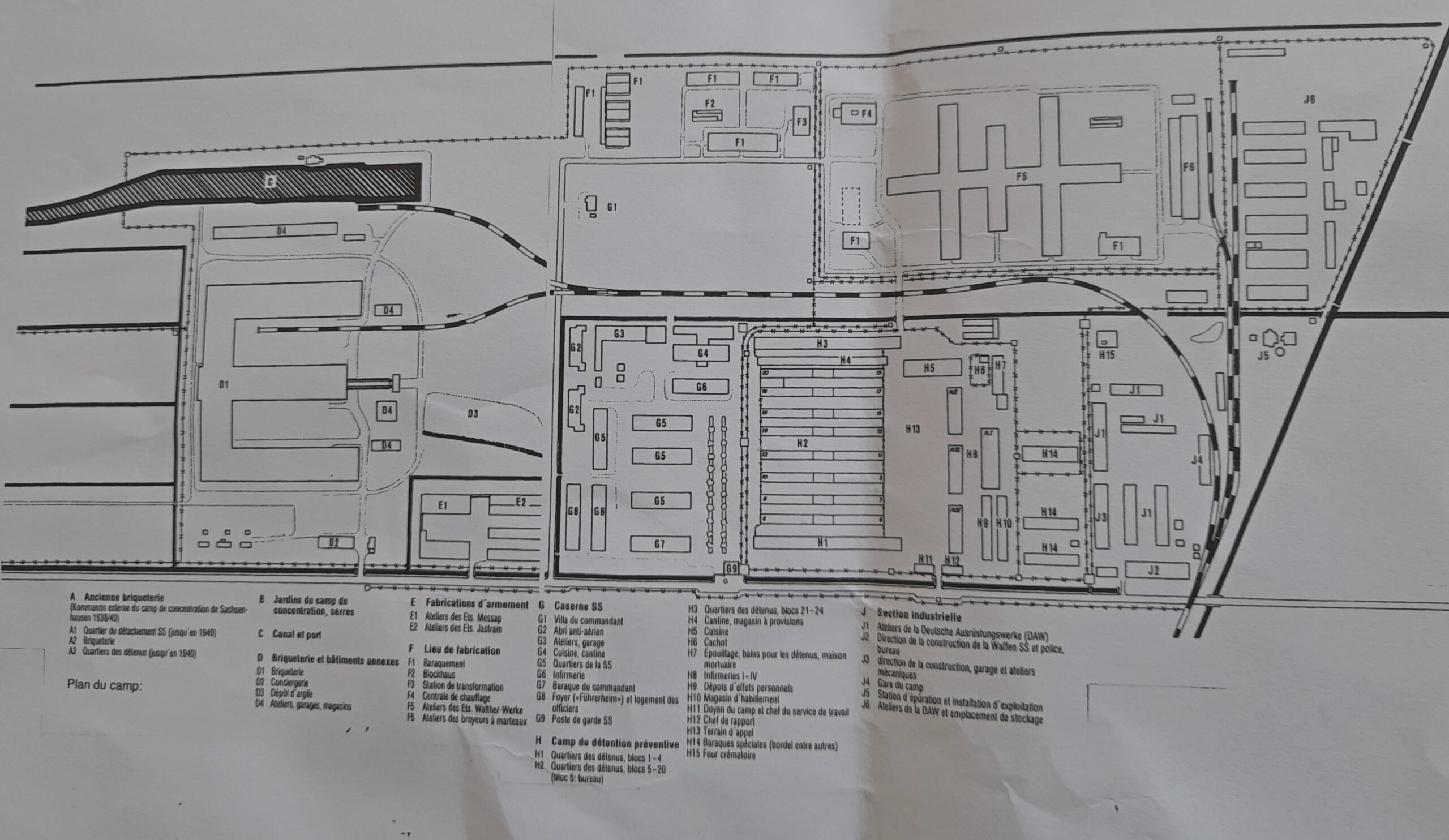
Camp map
The prisoners
The inmates were employed in the construction of the camp, the SS barracks and the new brickworks. Deportees participated in the channeling of the Dove-Elbe River, the drilling of the canal to lead to the brickworks, the construction of a dock for the docking of cargo ships and the manufacture of precision mechanics for the German navy.
Hamburg is one of the main ports for the Kriegsmarine (Navy).
In 1938, the prisoners were German (common criminals, delinquents, politicians, antisocials, gypsies, Jews). Then, up to 28 nationalities will be interned there.
106,000 will receive a number, including 13,500 women. 55,000 die (52%). Among them, 11,500 French. The first arrived in 1943, the majority between May and August 1944. 7,000 deaths.
The camp of Neuengamme, originally camp for adults, also internal teenagers and from 1944 children.
In the summer of 1944, women transferred from Auschwitz and Ravensbrück were assigned to Kommandos. 13,500 women receive a number, including more than 700 French women.
The working kommandos
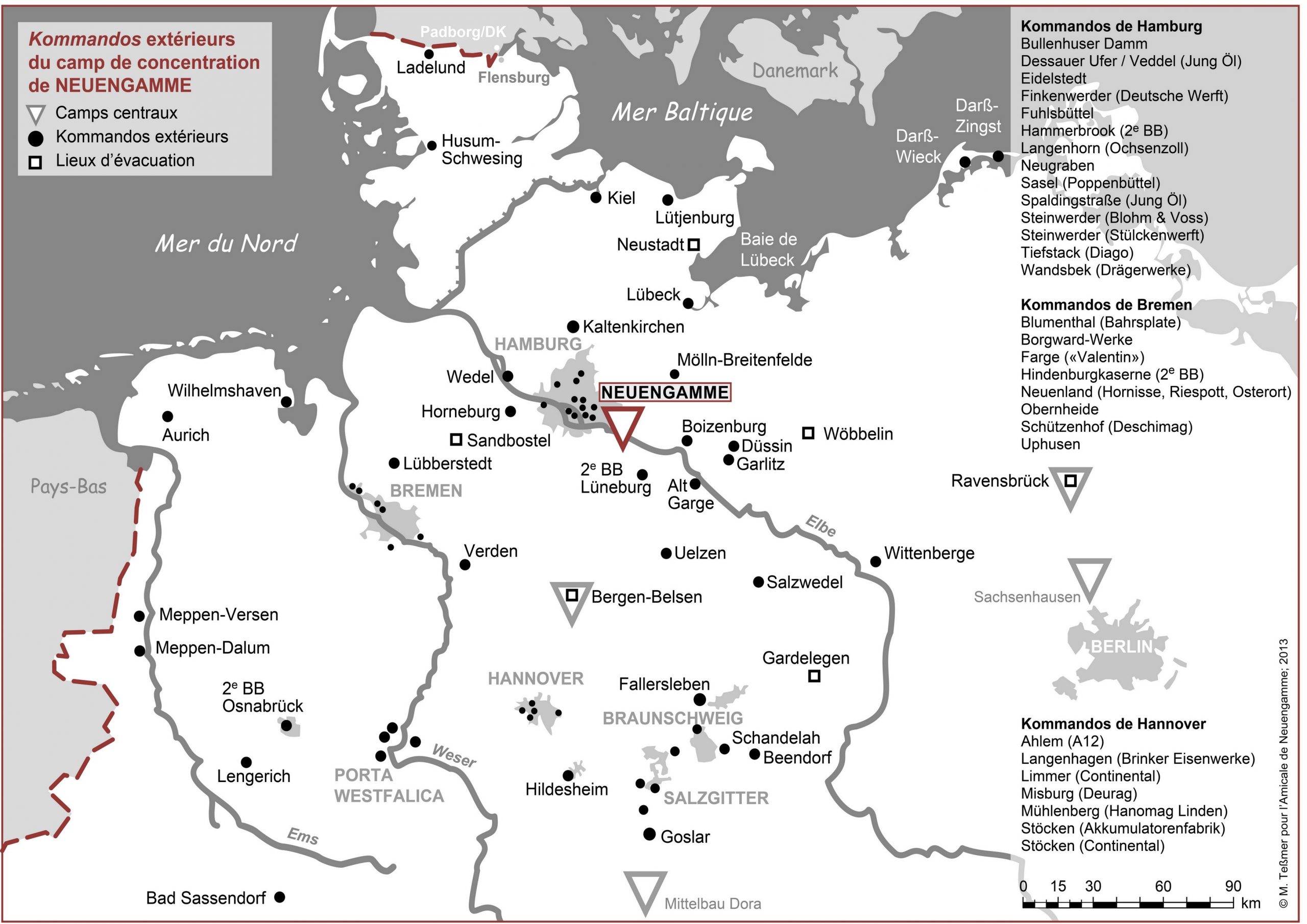
© Amicale française de Neuengamme
The concentration camp, kept secret, was not isolated. Several companies in the region used prisoners, cheap labor, in brickworks, arms industries (such as Walther pistols), in the construction of military facilities.
More than 80 Kommandos, 24 of whom are women, depend on the camp:
Bremen-Farge for the construction of a bunker for the production of submarines;
Elbe for the excavation of the Dove Elbe River;
Hamburg – Spaldingstrasse to defuse bombs, repair tracks after Allied bombing and build a bunker near Alster Lake;
Hannover-Ahlem to consolidate an asphalt roadway for underground weapons production;
Helmstedt-Beendorf to set up arms production workshops in two salt mines;
Ladelund to dig anti-tank trenches; 2,000 prisoners, 301 dead.
Lutjenburg-Hohwacht for the manufacture of precision compasses for V2 rockets;
Osnabrück to clear the rubble after the Allied bombing;
Salzgitter-Drutte for the production of pomegranates;
Schandelah to build a test plant to treat oil shale;
The kommando of braids: in humid cellars or outside, the weakest prisoners were responsible for braiding ropes and nets for the navy.
Medical experiments
Dr SS Kurt Heissmeyer carried out experiments with the tuberculosis bacillus on deportees and on twenty Jewish children, aged five to twelve, who arrived from Auschwitz on November 29, 1944.
Before the advance of the allies, these guinea pigs are transferred to Hamburg to the Bullenhuser Damm school, building that served as kommando of the camp since October 1944.
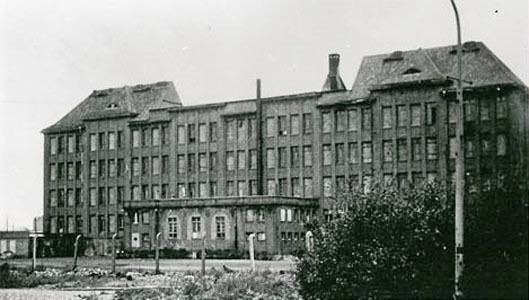
Bullenhuser Damm School © DR
On the night of 20 to 21 April 1945, in the basement of the school, these twenty children and twenty-eight adults including two French doctors (Dr Florence and Quenouille), two Dutch nurses and Soviet prisoners are hanged. The Nazis wanted to remove traces of experiments on human guinea pigs before the arrival of British troops.
Evacuations
From March 1945, the detainees of the camp and its kommandos were evacuated. Himmler did not want to leave any alive, as in the other camps. They are directed on foot « death steps » or freight cars to « assembly camps » such as Bergen-Belsen (8,000 detainees), Sandbostel (Stalag XB – 13 to 14 convoys between 12 and 19 April, 9,000 detainees) or Wöbbelin, Neuengamme side camp in Lugwigslust-Parchim district (5,000 deportees). These three places of destination are transformed into killing places, the deportees being abandoned without food, in appalling hygienic conditions.
During these «death marches», on April 15, before the arrival of American troops, near Gardelegen, arrival point of several transports, An SS detachment set fire to a barn where 1,016 deportees of all nationalities from the Dora camp and the Stocken kommando, dependent on Neuengamme, were gathered.
9 survivors. 711 unidentified bodies.
In March 1945, the Neuengamme concentration camp was the gathering point for all Norwegians and Danes deported to Germany. This is a concession granted by the Reichsführer SS Heinrich Himmler to the vice-president of the Swedish Red Cross, Count Folke Bernadotte. More than 4,000 Scandinavian deportees evacuated on 20 April 1945 to Sweden on «white buses»
From 19 to 26 April, trains carried more than 9,000 detainees to Lübeck on the Baltic coast. They are grouped aboard three vessels: the « Cap Arcona », the « Thielbek », the « Athen ».
Crammed into the holds, they will remain for several days, almost without supplies or water, without light or air, in the stench of excrement. The dead are stacked to save space.
On April 30, the Swedish Red Cross managed to rescue 400 French, Belgian and Dutch to repatriate them to Sweden (Operation Bernadotte).
The ships display the red flag with swastika. On 3 May, the pilots of the R.A.F. (Royal Air Force) of the British army which is bombing the city, think that the ships carry German troops and attack.
The « Cap Arcona » caught fire and capsized: out of 4,500 inmates, 350 survivors, including 11 French.
The «Thielbeck» sank in twenty minutes: out of 2,800 prisoners, 50 survivors including 4 French. «L’Athen» escapes the tragedy: 1,998 prisoners are safe.
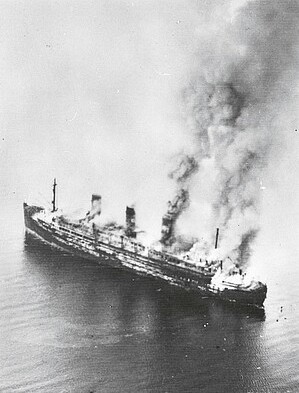
Cape Arcona in flames on May 3, 1945
© RAF – IWM, CR 227
Sources
– Amicale française de Neuengamme : https://www.campneuengamme.org
– Amis de la Fondation pour la Mémoire de la Déportation (AFMD) :
Revues Mémoire et Vigilance n°90 Janvier-mars 2020 et n°92 Juillet-septembre 2021
– Fondation pour la Mémoire de la Déportation (FMD) : Revues Mémoire Vivante, dossiers Neuengamme 2003 et Aurigny-Alderney 2009
– MARTIN-CHAUFFIER Luc, L’homme et la bête, éd. Gallimard, collection NRF, 1948
– http://www.kinder-vom-bullenhuser-damm.de/
– www.kz-gedenkstaette-neuengamme.de
– www.kz-gedenkstaette-in-hamburg.de
Neuengamme
Autonomous camp in 1940

© Vincent Gerbet
Monument Description
Carved by Pierre Honoré, Grand Prix de Rome, in the stone of Vilhonneur, the monument of Neuengamme, inaugurated on November 13, 1949, represents a figure of a woman crouching, her arms resting on an engraved block, her gaze lost in the distance.
It symbolizes the maintenance of hope and humanity having overcome brute force.
The female figure shows the traces of the weight loss and exhaustion of the deportees.
On the front of the block, are carved three flat silhouettes, pressed against each other. They testify to the fragility of the condition of the deportees, but also underline the importance of solidarity to maintain survival.
At the foot of the monument is a stone carved in tribute to the victims of «Cap Arcona». (A piece of wood from the boat has disappeared!).
On the stele is inscribed :
“Beneath this stone lies the ashes of the seven thousand French martyrs murdered by the Nazis at the Neuengamme camp.
They died so we could live free.
Their families and fellow survivors erected this monument in their memory.
13th November MCMXLIX”
Neuengamme camp

© FNDIRP
Since 1935, the SS had planned to build a new concentration camp near Hamburg. On 13 December 1938, the SS established a kommando outside the Sachsenhausen camp in Neuengamme, southeast of Hamburg on the Elbe, in a disused brickworks belonging to the Dest (see glossary).
The prisoners built a large concentration camp and a brickworks whose production was to be used to « modernize » the banks of the Elbe, to make Hamburg a showcase of National Socialism (major works, bridge over the Elbe, canal connecting the Elbe…).
The city of Hamburg finances the company with a loan of one million Reichsmarks.
Central camp of northwest Germany, it became autonomous in 1940 with more than 80 kommandos. His motto is: «Arbeit macht frei» (work makes you free).

Camp map
The prisoners
The inmates were employed in the construction of the camp, the SS barracks and the new brickworks. Deportees participated in the channeling of the Dove-Elbe River, the drilling of the canal to lead to the brickworks, the construction of a dock for the docking of cargo ships and the manufacture of precision mechanics for the German navy.
Hamburg is one of the main ports for the Kriegsmarine (Navy).
In 1938, the prisoners were German (common criminals, delinquents, politicians, antisocials, gypsies, Jews). Then, up to 28 nationalities will be interned there.
106,000 will receive a number, including 13,500 women. 55,000 die (52%). Among them, 11,500 French. The first arrived in 1943, the majority between May and August 1944. 7,000 deaths.
The camp of Neuengamme, originally camp for adults, also internal teenagers and from 1944 children.
In the summer of 1944, women transferred from Auschwitz and Ravensbrück were assigned to Kommandos. 13,500 women receive a number, including more than 700 French women.
The working kommandos

© Amicale française de Neuengamme
The concentration camp, kept secret, was not isolated. Several companies in the region used prisoners, cheap labor, in brickworks, arms industries (such as Walther pistols), in the construction of military facilities.
More than 80 Kommandos, 24 of whom are women, depend on the camp:
Bremen-Farge for the construction of a bunker for the production of submarines;
Elbe for the excavation of the Dove Elbe River;
Hamburg – Spaldingstrasse to defuse bombs, repair tracks after Allied bombing and build a bunker near Alster Lake;
Hannover-Ahlem to consolidate an asphalt roadway for underground weapons production;
Helmstedt-Beendorf to set up arms production workshops in two salt mines;
Ladelund to dig anti-tank trenches; 2,000 prisoners, 301 dead.
Lutjenburg-Hohwacht for the manufacture of precision compasses for V2 rockets;
Osnabrück to clear the rubble after the Allied bombing;
Salzgitter-Drutte for the production of pomegranates;
Schandelah to build a test plant to treat oil shale;
The kommando of braids: in humid cellars or outside, the weakest prisoners were responsible for braiding ropes and nets for the navy.
Medical experiments
Dr SS Kurt Heissmeyer carried out experiments with the tuberculosis bacillus on deportees and on twenty Jewish children, aged five to twelve, who arrived from Auschwitz on November 29, 1944.
Before the advance of the allies, these guinea pigs are transferred to Hamburg to the Bullenhuser Damm school, building that served as kommando of the camp since October 1944.

Bullenhuser Damm School © DR
On the night of 20 to 21 April 1945, in the basement of the school, these twenty children and twenty-eight adults including two French doctors (Dr Florence and Quenouille), two Dutch nurses and Soviet prisoners are hanged. The Nazis wanted to remove traces of experiments on human guinea pigs before the arrival of British troops.
Evacuations
From March 1945, the detainees of the camp and its kommandos were evacuated. Himmler did not want to leave any alive, as in the other camps. They are directed on foot « death steps » or freight cars to « assembly camps » such as Bergen-Belsen (8,000 detainees), Sandbostel (Stalag XB – 13 to 14 convoys between 12 and 19 April, 9,000 detainees) or Wöbbelin, Neuengamme side camp in Lugwigslust-Parchim district (5,000 deportees). These three places of destination are transformed into killing places, the deportees being abandoned without food, in appalling hygienic conditions.
During these «death marches», on April 15, before the arrival of American troops, near Gardelegen, arrival point of several transports, An SS detachment set fire to a barn where 1,016 deportees of all nationalities from the Dora camp and the Stocken kommando, dependent on Neuengamme, were gathered.
9 survivors. 711 unidentified bodies.
In March 1945, the Neuengamme concentration camp was the gathering point for all Norwegians and Danes deported to Germany. This is a concession granted by the Reichsführer SS Heinrich Himmler to the vice-president of the Swedish Red Cross, Count Folke Bernadotte. More than 4,000 Scandinavian deportees evacuated on 20 April 1945 to Sweden on «white buses»
From 19 to 26 April, trains carried more than 9,000 detainees to Lübeck on the Baltic coast. They are grouped aboard three vessels: the « Cap Arcona », the « Thielbek », the « Athen ».
Crammed into the holds, they will remain for several days, almost without supplies or water, without light or air, in the stench of excrement. The dead are stacked to save space.
On April 30, the Swedish Red Cross managed to rescue 400 French, Belgian and Dutch to repatriate them to Sweden (Operation Bernadotte).
The ships display the red flag with swastika. On 3 May, the pilots of the R.A.F. (Royal Air Force) of the British army which is bombing the city, think that the ships carry German troops and attack.
The « Cap Arcona » caught fire and capsized: out of 4,500 inmates, 350 survivors, including 11 French.
The «Thielbeck» sank in twenty minutes: out of 2,800 prisoners, 50 survivors including 4 French. «L’Athen» escapes the tragedy: 1,998 prisoners are safe.

Cape Arcona in flames on May 3, 1945
© RAF – IWM, CR 227
Sources
– Amicale française de Neuengamme : https://www.campneuengamme.org
– Amis de la Fondation pour la Mémoire de la Déportation (AFMD) :
Revues Mémoire et Vigilance n°90 Janvier-mars 2020 et n°92 Juillet-septembre 2021
– Fondation pour la Mémoire de la Déportation (FMD) : Revues Mémoire Vivante, dossiers Neuengamme 2003 et Aurigny-Alderney 2009
– MARTIN-CHAUFFIER Luc, L’homme et la bête, éd. Gallimard, collection NRF, 1948
– http://www.kinder-vom-bullenhuser-damm.de/
– www.kz-gedenkstaette-neuengamme.de
– www.kz-gedenkstaette-in-hamburg.de
Délégation de Paris des Amis de la Fondation
pour la Mémoire de la Déportation
31 Boulevard Saint-Germain 75005 Paris
Contact : afmd.dt75@gmail.com
©AFMD75

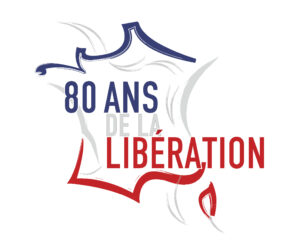
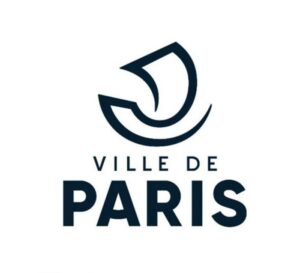

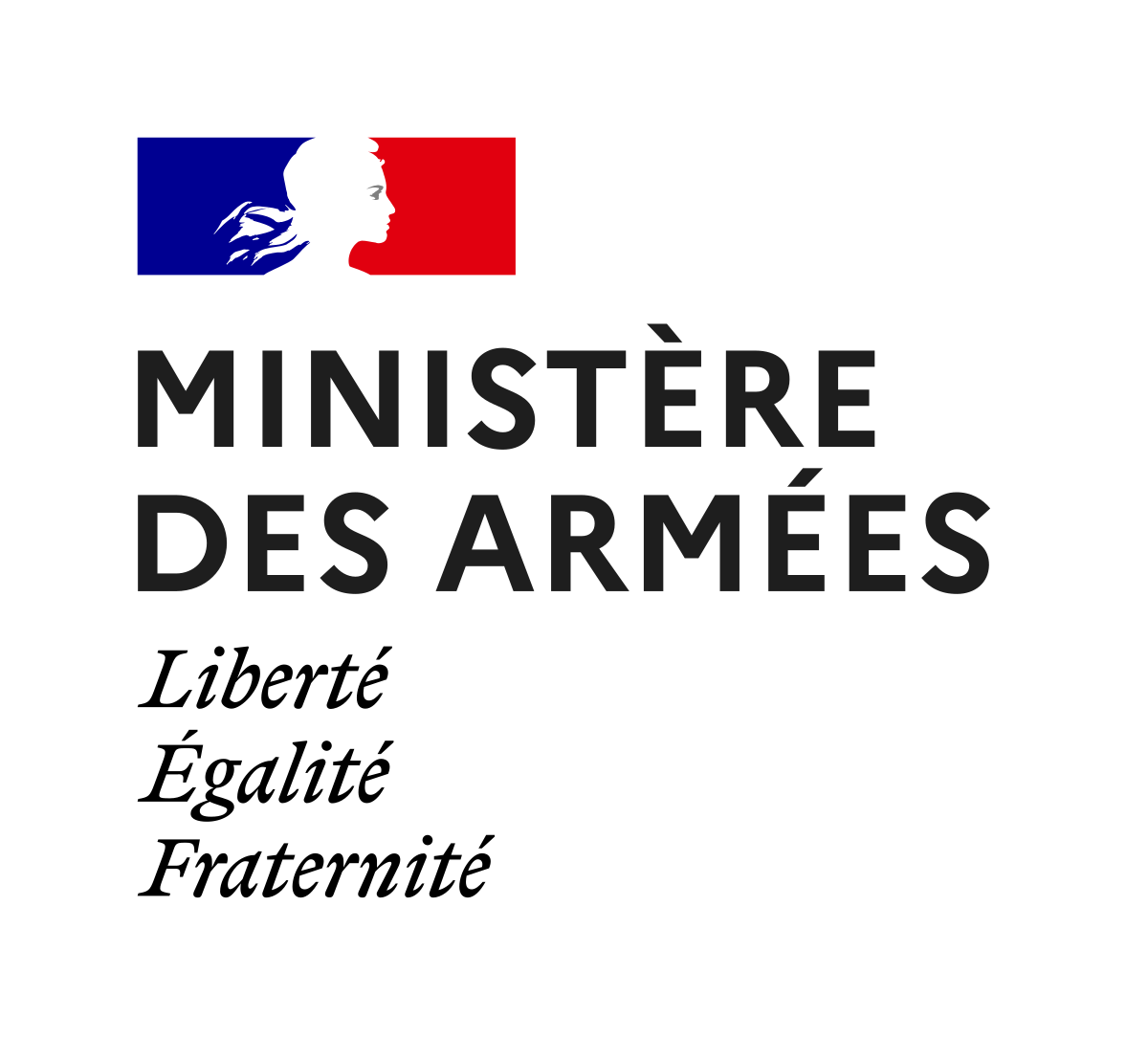
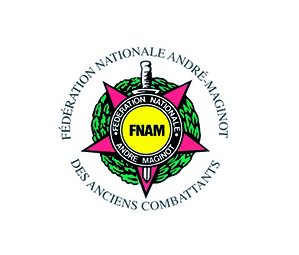
Délégation de Paris
des Amis de la Fondation
pour la Mémoire de la Déportation
31 Boulevard Saint-Germain
75005 Paris
Contact :
afmd75@gmail.com
©AFMD75
Délégation de Paris
des Amis de la Fondation
pour la Mémoire
de la Déportation
31 Boulevard Saint-Germain
75005 Paris
Contact
afmd75@gmail.com
©AFMD75

